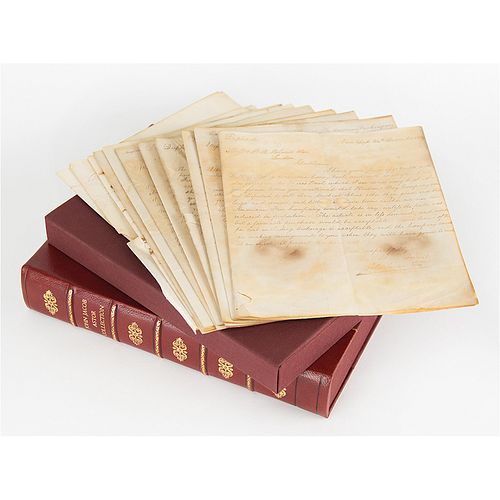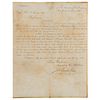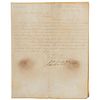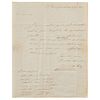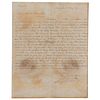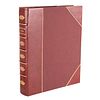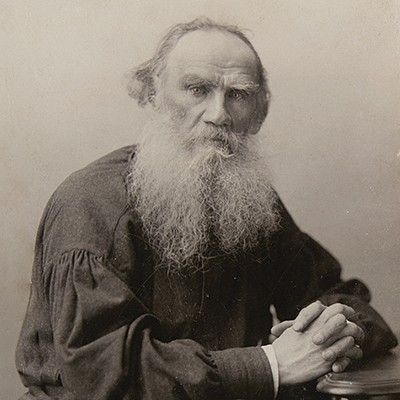John Jacob Astor Archive of (14) Letters and Documents
Two ways to bid:
- Leave a max absentee bid and the platform will bid on your behalf up to your maximum bid during the live auction.
- Bid live during the auction and your bids will be submitted real-time to the auctioneer.
Bid Increments
| Price | Bid Increment |
|---|---|
| $0 | $5 |
| $50 | $10 |
| $200 | $25 |
| $500 | $50 |
About Auction
Apr 12, 2023
RR Auction support@rrauction.com
- Lot Description
Important collection of 14 letters and documents, 13 of them signed by John Jacob Astor, amounting to 20 pages total, dating from 1802 to 1827. The archive is housed in a handsome custom-made three-quarter morocco case with engraved frontispiece portrait of Astor, featuring his facsimile signature.
John Jacob Astor, founder of the Astor business dynasty, was the first American multimillionaire. In his time he was 'the richest and most powerful of American businessmen. He came to personify nineteenth-century American business leadership, and he became a favorite subject for both capitalism’s apologists and detractors' (Haeger).
Astor began trading furs in the 1780s. By 1808, the year of the founding of his American Fur Company, he had become the leading American fur merchant. In the following years Astor made fortunes in the China trade and in New York real estate. He was by far the wealthiest person in American history before the railroad era.
This remarkable collection documents Astor’s wide-ranging contributions to American business and financial history. These letters track the growth of Astor’s enterprises and his vast ambition. In an 1802 letter he asks a merchant in Schenectady for 100 bear skins and names the prices he will pay for various furs. By 1812 Astor is trading gold and paper money with the state bank of New York. Just five years later Astor, having helped to establish the Second Bank of the United States, is shaping its activities to his purposes. Astor also made a fortune in the China trade, a fact reflected in the letter to his longtime partner N. C. Ogden (1776-1823). Ogden handled Astor’s affairs in Canton, the two doing business on a stupendous extent. In a document dated 1823 Astor buys nearly 150,000 muskrat skins! By 1827, when he begins doing business with Poland & Son in London, he is a giant of the fur trade, dictating terms and doing business on a vast scale.
A highlight of the collection is the run of seven Astor letters to London fur merchant Peter R. Poland & Son. The file begins with Astor accepting, on a trial basis, Poland’s offer to act as his agent in London. In the ensuing letters Astor objects to Poland’s fees, addresses market conditions, discusses the difficulties of transatlantic business communications, specifies the animal furs he seeks and the quality he requires, and haggles over terms and prices. Astor’s intimate familiarity with the fur market is on full display in this correspondence.
Ultimately Astor piles on additional orders, doing business on a staggering scale amounting to many hundreds of thousands of furs in the first year alone. The letters to P. R. Poland & Son are marked “duplicate,” yet they bear stamps and seals indicating that they traveled across the Atlantic. It is evident that Astor sent two copies of each letter, using different packet ships, to ensure that his communications reached Poland in a timely manner. In the fur business timing was everything, “it being important to have early information,” as Astor writes.
Another highlight is the outstanding pair of letters written by Astor in 1817 to the head of the Bank of the United States concerning financial matters. In 1815 Astor had joined with several other prominent men, including banker Stephen Girard and Senator John C. Calhoun, to establish the Second Bank of the United States. Anti-Federalist sentiment had killed Alexander Hamilton’s Bank of the United States by 1811. Astor and the other founders saw a national bank as essential for a stable supply of money and credit, economic growth, and westward expansion. William Jones, installed as the first president of the Bank, exacerbated financial tensions with his inept handling of its affairs, driving the country into recession. In these letters to Jones, Astor expresses his frustration with the Bank’s policies and with the money market and attempts to reshape them.
This important collection documents Astor’s unparalleled activities at the dawn of American large-scale capitalism. Complete transcripts of the archive are available online at RRAuction.com. In very good to fine condition, with toning and dampstaining to most of the letters, and occasional tears and fold separations. - Shipping Info
-
Bidder is liable for shipping and handling and providing accurate information as to shipping or delivery locations and arranging for such. RR Auction is unable to combine purchases from other auctions or affiliates into one package for shipping purposes. Lots won will be shipped in a commercially reasonable time after payment in good funds for the merchandise and the shipping fees are received or credit extended, except when third-party shipment occurs. Bidder agrees that service and handling charges related to shipping items which are not pre-paid may be charged to a credit card on file with RR Auction. Successful international Bidders shall provide written shipping instructions, including specified Customs declarations, to RR Auction for any lots to be delivered outside of the United States. NOTE: Declaration value shall be the item’(s) hammer price and RR Auction shall use the correct harmonized code for the lot. Domestic Bidders on lots designated for third-party shipment must designate the common carrier, accept risk of loss, and prepay shipping costs.
-
- Buyer's Premium



 EUR
EUR CAD
CAD AUD
AUD GBP
GBP MXN
MXN HKD
HKD CNY
CNY MYR
MYR SEK
SEK SGD
SGD CHF
CHF THB
THB